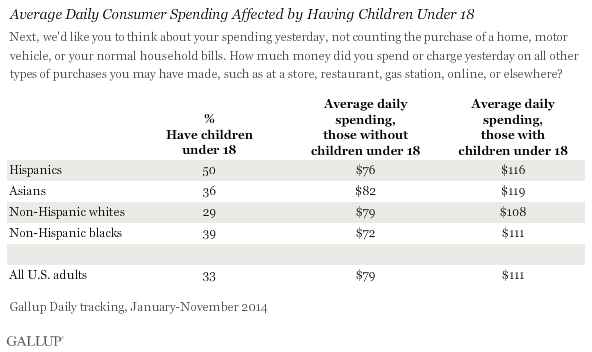Story Highlights
- Hispanics spend more per day than U.S. average: $96 vs. $90
- Americans with children younger than 18 spend more
- Hispanics are ethnic group most likely to have children
WASHINGTON, D.C. -- Hispanic adults in the U.S. in 2014 have reported spending more money on a daily basis, on average, than is typical for the U.S. adult population: $96 vs. $90, respectively.

These results are based on interviewing conducted as part of 2014 Gallup Daily tracking, which asks Americans how much they spent "yesterday," excluding normal household bills and major purchases. It provides an indication of discretionary consumer spending. So far in 2014, daily spending averages for most months have been slightly higher than in the corresponding month in 2013, and overall average daily spending to date in 2014 is slightly higher than what was found in 2013.
President Barack Obama's recent executive action would defer the deportation of millions of immigrants who are in the U.S. illegally, many of them Hispanic. This raises the question of the potential effect this move will have on the U.S. economy. Hispanics are joined by Asians as the largest spenders this year among major racial and ethnic groups, reporting significantly higher spending than non-Hispanic whites or blacks. This suggests a potential benefit to the consumer spending component of the economy if these Hispanic immigrants remain in the U.S. rather than being returned to their native countries.
Children Large Part of Reason for Higher Hispanic Spending
One likely reason Hispanics report higher average spending than whites and blacks is that they are more likely to have children younger than 18 living in their households. Half of Hispanics report having children younger than 18, compared with 29% of whites, 39% of blacks and 36% of Asians. Previously, Gallup has found that having children is associated with higher daily spending, and analysis of 2014 data shows that within each major racial and ethnic group, those who have children spend substantially more than those who do not.

The significant proportion of Hispanics with children gives this group -- with its higher spending average -- a major representation in Hispanics' overall spending average. On the other hand, the lower level of spending associated with not having children under 18 has much higher weight among the overall total of all Americans. Thus, Hispanics' youthful average age and their resulting higher likelihood of having children in the home translate into higher overall spending.
Implications
One major element of Obama's executive action on immigration would allow immigrants whose children meet certain qualifications to avoid active deportation efforts and thus to remain in the U.S. Many of those who would avoid deportation would be Hispanics with children. If these immigrants are similar to Hispanics in general, they are likely to spend more than the average American, helping to contribute to the U.S. retail economy, particularly in cities and regions where Hispanics constitute a higher percentage of the population than in others. There are certainly other, countervailing economic implications of allowing these individuals to remain in the U.S., but in terms of the consumer economy, the net effect would likely be a positive one.
Survey Methods
Results for this Gallup poll are based on telephone interviews conducted Jan. 1-Nov. 30, 2014, on the Gallup U.S. Daily survey, with a random sample of 159,068 adults, aged 18 and older, living in all 50 U.S. states and the District of Columbia. For results based on the total sample of national adults, the margin of sampling error is ±1 percentage point at the 95% confidence level. For results based on the total sample of 14,538 Hispanics, the margin of sampling error is ±1 percentage point at the 95% confidence level. For results based on the total sample of 6,358 Hispanics with children, the margin of sampling error is ±2 percentage points at the 95% confidence level. All reported margins of sampling error include computed design effects for weighting.
Each sample of national adults includes a minimum quota of 50% cellphone respondents and 50% landline respondents, with additional minimum quotas by time zone within region. Landline and cellular telephone numbers are selected using random-digit-dial methods.
Learn more about how Gallup Daily tracking works.

